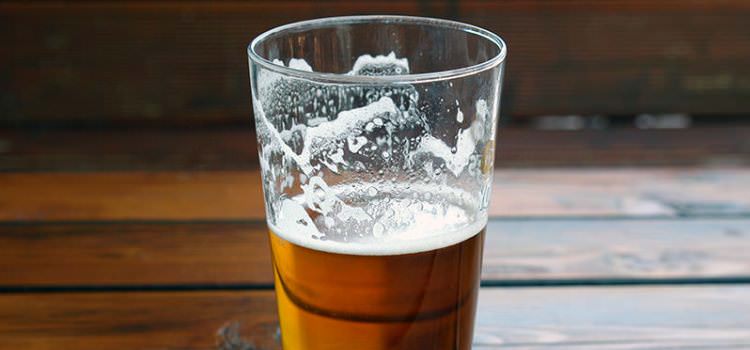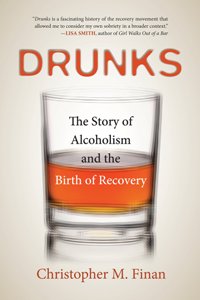Drunks: The Story of Alcoholism and the Birth of Recovery

Review by Tom S.
A wise man once said, “Every drunk is not an alcoholic but every alcoholic is a drunk.” I’ve always liked that line and I believe it to be true. I have known many heavy drinkers who could be labeled a drunk who did not necessarily have the mental obsession that is found in every alcoholic. These “drunks” can quit, stop or control their drinking when the need arises.
Drunks: The Story of Alcoholism and the Birth of Recovery is a book that covers drunks and alcoholics alike. Beginning with the Native American Indians and carrying the reader through the Washingtonian Movement, onward to Prohibition, past Dr. Bob Smith and Bill Wilson and on to the Betty Ford Hazelden Foundation.
Drunks takes us on the wild ride that anyone who has taken even one drink knows alcohol is capable of providing.
Christopher Finan has unveiled the facts that while it is true alcohol has been around for what seems like forever it is also true that the trials and tribulations that go along with it, including full blown alcoholism, have been with us every step of the way.
Finan begins his journey down the Inebriation Highway with the Native Americans of the American Revolution era. He introduces the reader to an American Indian in his 50’s named Handsome Lake. Handsome Lake and his mates had lost everything to the point where he called himself nothing but “yellow skin and dried bones.” Alcohol had destroyed his life.
Finan tells the story of Handsome Lake’s remarkable spiritual “vision” he experienced one day outside his cabin home. He was struck down and thought to be dead. When he arose he told a tale of hope. The story of Handsome Lake’s subsequent prophecy and his stories of salvation from alcohol are captivating to say the least.
Drunks tells the fascinating story of a six foot tall, 175 pound woman who would stand at the door of saloons and ask the men drinking inside to let her in. Once inside she would proceed to smash everything she could see using weapons such as bricks, stones and finally the weapon of her own mass destruction, a seven-pound hatchet that once belonged to the railroad. Her name was Carry Nation and she was, like the Blues Brothers, on a mission from God. Basically, Ms. Nation would warn the owners and patrons of drinking establishments to vacate the premises or she would return in a couple of days and destroy the place.
Finan explains in his story of Carry Nation how she came to be on this mission of mercy. While she was a teenager living with her parents in Missouri, she married a drunk named Charles Gloyd, a Civil War veteran. After figuring out he was a no-good drunkard she left him and fell on hard times. As Prohibition was taking the nation by storm, there were many establishments that stayed open and simply paid the fine. Carry didn’t like that very much.
After going on her “smashing” spree she was hailed a hero by fellow prohibitionists. I’ve often wondered myself whether Ms. Nation’s way of combating alcoholism wouldn’t work today with some stubborn alcoholics. I can just imagine my sponsor telling me to get started writing my 4th step inventory while holding a hatchet in his hands. I’m pretty sure that would have shortened my procrastination.
Naturally, Drunks takes on the Dr. Bob and Bill Wilson journey as well. Finan appropriately titles the chapter regarding the founders of Alcoholics Anonymous “Two Drunks.” After all, that’s what they were deepest to their core: two drunks. Finan gives profound information and viewpoint into Wilson’s alcoholism and his never-ending efforts to control his drinking. How time after time Lois Wilson dealt with his failures. How she finally gave him up for dead as he lay hopelessly in a Towns Hospital bed under the care of the famous (to recovered alcoholics) Dr. William Silkworth.
The book tells of Bill’s last debacle on Armistice Day and of Ebby Thatcher’s visit and conversation in Bill’s kitchen. It examines the blazing white light in Bill’s room and the depth of his “spiritual awakening.” Most of all Drunks tells the story of how after leaving Towns Hospital for the last time, Bill Wilson embarked on his mission to change the world and save drunks everywhere.
Finan does a masterful job digging a little deeper and finding different angles in telling a story that has been told as many times as Wilson’s has. It is intriguing to the reader to see how Bill began to separate from the Oxford Group. Drunks explains how the Oxford Group was evangelistic and set on saving souls. Bill Wilson was only concerned with saving alcoholics. Therefore it seems only logical that Wilson and the alcoholics of the Oxford Group began to meet after the meetings. These meetings after the meeting were basically the first AA meetings.
Drunks moves forward in describing the first meeting between Bill and Dr. Bob. Finan explains how one of the first things Wilson said to Dr. Bob was, “You look like you could use a drink.” If you are anything like me that line hits home in its perfection.
Additionally, Finan does a wonderful job in dissecting the role the Oxford Group played in the founding and creation of Alcoholics Anonymous. He goes into depth on Wilson’s struggles with writing the 12 Steps and how the four spiritual practices of the Oxford Group influenced them. He quotes Wilson when Bill said, “Finally, I started to write.” When reading Finan’s words it has become easier for me to envision the difficulties Wilson had in writing the 12 Steps because of all the expectations and alcoholic rationalizing that were present in the 1930s.
No book on alcohol, alcoholism and drunks would be complete without a certain number of pages devoted to Betty Ford. There is the wonderful story of how Betty’s daughter Susan approached her gynecologist, who just happened to be a recovered alcoholic, about a “friend” of hers who had a problem. The doctor asked immediately if it was her mother. The two of them planned an intervention for Betty not long after their meeting.
During this intervention Betty was given choices as to how to work her recovery. One of her choices was to go to treatment at Hazelden, a rehabilitation center in Minnesota. Hazelden was the largest rehabilitation center in the country. It occupied 200 acres of former farmland. It had a big white house with a red roof that had 17 spacious rooms. In the 1960s new buildings were added and the facility could handle over 150 patients.
Drunks tells us that the core of the Hazelden program is the 12 Steps. After all, this is a book about drunks and Hazelden has housed many of them. The book tells us the story of the first man to get sober there was Pat Cronin. Finan explains in great detail how drunks get sober at Hazelden and through its successes Hazelden became a main factor in the growth of private treatment centers. Finan also explains how the insurance companies, by covering fees from rehabilitation, were instrumental in the growth and expansion of these centers. In 1970, there were only a handful of private treatment centers, but by the 1980s there were 3800 residential beds in Minnesota alone.
I have merely scratched the surface as to the extent that Drunks: The Story of Alcoholism and the Birth of Recovery digs. I think you get the picture though. Not only is this book thorough in its research, it is also expansive. Christopher Finan’s travels through a drunken American history is eye-opening as well as blurry-eyed.
Tom S. is 53 years old and has been sober since February 11th, 2012. Through the grace of this program, good sponsorship, strong fellowship and the 12 Steps he has been able to find happiness, joy and freedom. Having been a heavy drinker for over 33 years, Tom finally found the answer one night standing alone on his back porch. “What if I just quit drinking?” Having recovered from a seemingly hopeless state of mind and body Tom along with his wife of 25 years has been able to raise his twins, Michael and Janie and watch them grow into the young adults they have become. Being a strong father is the greatest gift sobriety has given him. Tom calls the 3-11 Group that meets on Wednesday nights in the suburbs of Chicago his home group. Long timers and newcomers are welcomed and assist each other to stay sober one day at time.
 The book can be purchased at an independent book store. You can do that by clicking here: IndieBound – A Community of Independent Local Book Stores.
The book can be purchased at an independent book store. You can do that by clicking here: IndieBound – A Community of Independent Local Book Stores.
Drunks is also available at Amazon USA. This the paperback edition. It is also available as a hardcover, Kindle and audio book or CD.
Please note that while the hardcover and audios have a different cover and subtitle – “An American History” – it’s the same book.

























I hate labels. I introduce my self as Ed Sweeney, I used to drink too much.
Thanks Ed. I agree with your comment about labels. My name is Matt Wyneken, and I used to drink too much, too. With 23 million Americans living in recovery of some form, every single one of us needs to take some pride in our progress. We are living examples of the Promises who can offer hope for those still suffering.
Alcoholics Anonymous is infatuated with labels. That matches the strong bent to black and white thinking. Here’s A and here’s B. God forbid (pardon the expression) that anything might be some sort of AB combination. ?
In one of life’s delicious ironies, I’ve been re-reading “Drunks” over the past few days. It’s quite nicely written and, although I have an intimate familiarity with the subject matter, the book contains information new to me, such as the tale of Handsome Lake. I also didn’t know more than the general story of Betty Ford, so there was much in that chapter that I found enlightening.
The book is ambitious in tackling the entire drinking-recovery era in America, so there are inevitable omissions. Nonetheless, the book is WELL worth reading.
I’d be remiss if I didn’t acknowledge one of the great lines in AA Agnostica history, fired off by our reviewer:
LOVED that one!!!
Just getting ready to read this article, but as for the front comments, the grapevine is pre-approved, their argument doesn’t hold water, sigh, one more battle to fight…
Thanks for the nice review! I just ordered the book and look forward to reading it.
Linda
The way I heard it was, “not every drunk is an alcoholic and not every alcoholic is drunk”.
Excellent review. I’ve ordered it.
Thank you!
I’ve been really enjoying this book. Thanks for the review Tom.
Chris is a great story teller. It’s the gripping personal intrigue – not the chronology of factual events – that makes this book so vital (for me, anyway). I showed it off at NAADAC (Professional Organization for Addiction Treatment workers) this weekend.